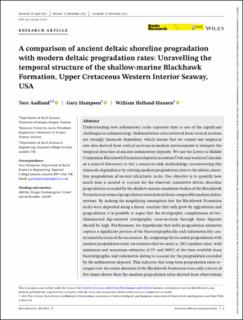| dc.contributor.author | Aadland, Tore | |
| dc.contributor.author | Hampson, Gary | |
| dc.contributor.author | Helland-Hansen, William | |
| dc.date.accessioned | 2023-03-01T13:22:17Z | |
| dc.date.available | 2023-03-01T13:22:17Z | |
| dc.date.created | 2023-01-03T13:04:34Z | |
| dc.date.issued | 2022 | |
| dc.identifier.issn | 0950-091X | |
| dc.identifier.uri | https://hdl.handle.net/11250/3055034 | |
| dc.description.abstract | Understanding how sedimentary rocks represent time is one of the significant challenges in sedimentology. Sedimentation rates retrieved from vertical sections are strongly timescale dependent, which means that we cannot use empirical rate data derived from vertical sections in modern environments to interpret the temporal structure of ancient sedimentary deposits. We use the Lower to Middle Campanian Blackhawk Formation deposits in eastern Utah and western Colorado as a natural laboratory to test a source-to-sink methodology circumventing this timescale dependence by relating modern progradation rates to the deltaic shoreline progradation of ancient siliciclastic rocks. Our objective is to quantify how much time is needed to account for the observed cumulative deltaic shoreline progradation recorded by the shallow-marine sandstone bodies of the Blackhawk Formation in terms of progradation rates derived from comparable modern deltaic systems. By making the simplifying assumption that the Blackhawk Formation rocks were deposited along a linear coastline that only grew by aggradation and progradation, it is possible to argue that the stratigraphic completeness of two-dimensional dip-oriented stratigraphic cross-sections through these deposits should be high. Furthermore, we hypothesise that delta progradation estimates capture a significant portion of the biostratigraphically and radiometrically constrained duration of the succession. By comparing the recorded progradation with modern progradation rates, we estimate that we need ca. 20% (median value, with minimum and maximum estimates of 2% and 300%) of the time available from biostratigraphic and radiometric dating to account for the progradation recorded by the sedimentary deposits. This indicates that long-term progradation rates averaged over the entire duration of the Blackhawk Formation were only a factor of five times slower than the modern progradation rates derived from observations over periods that are five to six orders of magnitude shorter. We conclude that a significant amount of time is represented by prograding deltaic shoreline deposits and that by considering the cumulative shoreline progradation, we could limit the effects of timescale dependence on the rate estimates used in our analysis. | en_US |
| dc.language.iso | eng | en_US |
| dc.publisher | Wiley | en_US |
| dc.rights | Attribution-NonCommercial-NoDerivatives 4.0 Internasjonal | * |
| dc.rights.uri | http://creativecommons.org/licenses/by-nc-nd/4.0/deed.no | * |
| dc.title | A comparison of ancient deltaic shoreline progradation with modern deltaic progradation rates: Unravelling the temporal structure of the shallow-marine Blackhawk Formation, Upper Cretaceous Western Interior Seaway, USA | en_US |
| dc.type | Journal article | en_US |
| dc.type | Peer reviewed | en_US |
| dc.description.version | publishedVersion | en_US |
| dc.rights.holder | Copyright 2022 The Author(s) | en_US |
| cristin.ispublished | true | |
| cristin.fulltext | original | |
| cristin.qualitycode | 2 | |
| dc.identifier.doi | 10.1111/bre.12737 | |
| dc.identifier.cristin | 2099635 | |
| dc.source.journal | Basin Research | en_US |
| dc.identifier.citation | Basin Research. 2022 | en_US |

